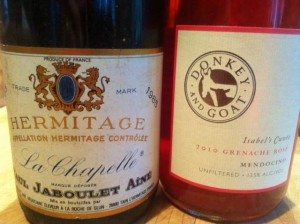 Just like clocks striking twelve, our cellar coughs up one bottle of 1985 wine every year on April 14. My wife and I were lucky to be married in this vintage year. The Bordeaux have aged gracefully despite the vintage’s early accessibility, northern Rhones are holding onto their fruit even now, 1985 Sassicaia made our evening somewhere in the late nineties, southern Rhones were glorious in the teen years of our marriage, and some California cabernets are still hanging in there with alluring secondary aromatics. This year, the wine and our marriage’s 27th, we drank 1985 Jaboulet La Chapelle.
Just like clocks striking twelve, our cellar coughs up one bottle of 1985 wine every year on April 14. My wife and I were lucky to be married in this vintage year. The Bordeaux have aged gracefully despite the vintage’s early accessibility, northern Rhones are holding onto their fruit even now, 1985 Sassicaia made our evening somewhere in the late nineties, southern Rhones were glorious in the teen years of our marriage, and some California cabernets are still hanging in there with alluring secondary aromatics. This year, the wine and our marriage’s 27th, we drank 1985 Jaboulet La Chapelle.
Anticipating how the awesomeness of this Hermitage would set up our evening, the bottle stood for two days in the cellar and was decanted one hour before service. But it was unusually warm for mid April in Boston, hovering at 85°F. It called for a refreshing start to our quiet meal at home with friends. Last year I bought, and forgot about, one bottle of $21 2010 Donkey and Goat Isabel’s Cuvee Grenache Rosé. The warm evening and accompanying northern Rhone elder wine framed a perfect backdrop to the salmon colored grenache from Jared and Tracey Brandt’s limited production natural wine program.
 While the La Chapelle sat in the decanter, familiarizing itself with its first new glass enclosure in 27 years, we lifted the rosé off its thick sediment that lined the bottle’s punt for all its 360° (you can see it at the bottom of the bottle in the photo to the left if you look carefully). Evidently, the unfiltered wine tossed this grey/white ringworm effect even before release.
While the La Chapelle sat in the decanter, familiarizing itself with its first new glass enclosure in 27 years, we lifted the rosé off its thick sediment that lined the bottle’s punt for all its 360° (you can see it at the bottom of the bottle in the photo to the left if you look carefully). Evidently, the unfiltered wine tossed this grey/white ringworm effect even before release.
Pause. Wine experiences are streams of never ending improvisational jams around familiar compositions. Wines like these, served together with one meal, create exciting musical juxtaposition by contributing their utterly different, yet beautiful and complementary tonality. Combinations of wines like this create experiences that will never render wine enthusiasm boring.
For sure, I assumed the La Chapelle would be the highlight wine. It was wonderful; browning at the edges. The nose had old leather, dank cellar and cardboard aromas with dusty black cherry notes. It achieved full maturity and was probably in decline. Still, the purity of the old fruit flavors were hanging on by their finger nails, with the tannins standing a bit firmer than I would have preferred in the context of the thinning fruit. The wine was still a beautiful old thing, elegant with herb and cassis flavors and a regally smooth, if not really luscious, mouthfeel. It finished with all the beauty that fully mature wines can muster. It’s a classic old syrah that yielded the rewards of patience. It’s time to drink all the 1985 La Chapelle you have left. While storage and bottle variability could yield different results for you, mine will no longer improve.
 The Donkey and Goat was full of zippy acidity, feigning (or actually having?) sprtiz. The salmon color was enticing, tasting at one moment like raspberry baked goods, and then showing off serious herbal fragrances. A little more time in the glass and stewed strawberries arose alongside the herbal aromas. The acidity always remained strict. The wine wakes your senses, exciting, every sip another monumental and playful indulgence. It is one of the most exciting and interesting rosés I have ever experienced. We had some left in the bottle two days later and the acidity remained powerful while the intensity of flavors did not wane nor hardly change a bit; a powerful rosé it its own right.
The Donkey and Goat was full of zippy acidity, feigning (or actually having?) sprtiz. The salmon color was enticing, tasting at one moment like raspberry baked goods, and then showing off serious herbal fragrances. A little more time in the glass and stewed strawberries arose alongside the herbal aromas. The acidity always remained strict. The wine wakes your senses, exciting, every sip another monumental and playful indulgence. It is one of the most exciting and interesting rosés I have ever experienced. We had some left in the bottle two days later and the acidity remained powerful while the intensity of flavors did not wane nor hardly change a bit; a powerful rosé it its own right.
The old and the new, side by side creating a symphony of riveting wine experience, yet from opposing corners of the geographic and stylistic spectrum of wine. Who dreamed a newborn northern California natural pink wine would hold our attention next to a venerable 27 year old Hermitage? The beauty of wine…happy anniversary to us!